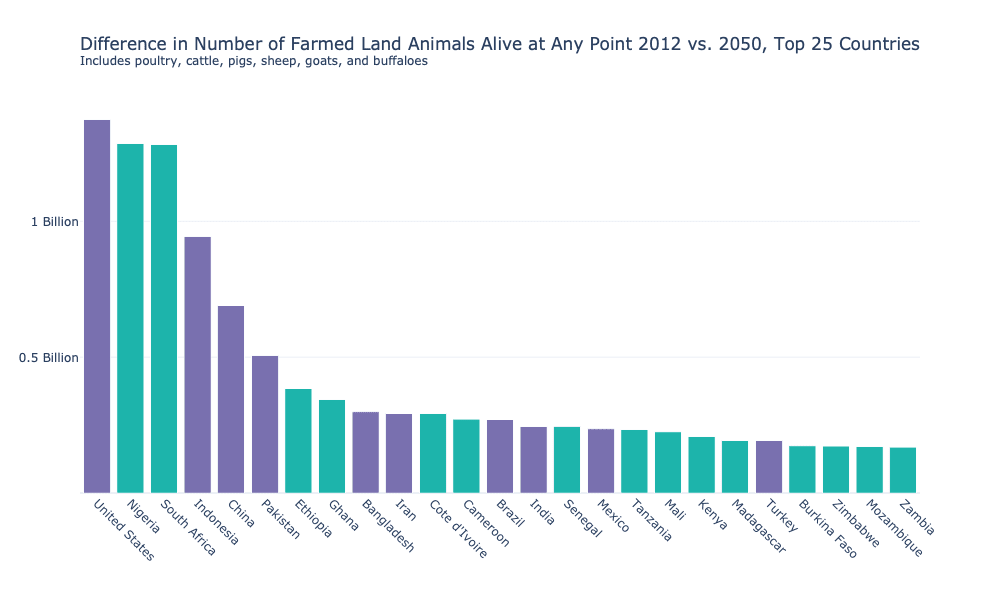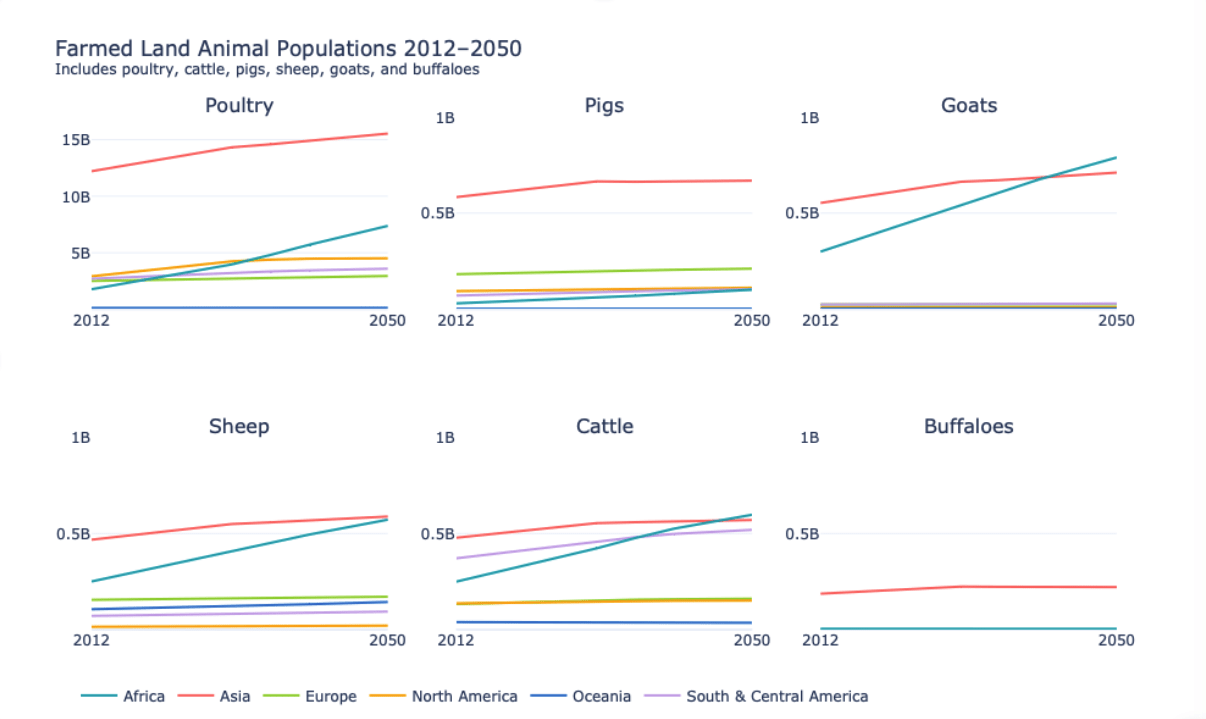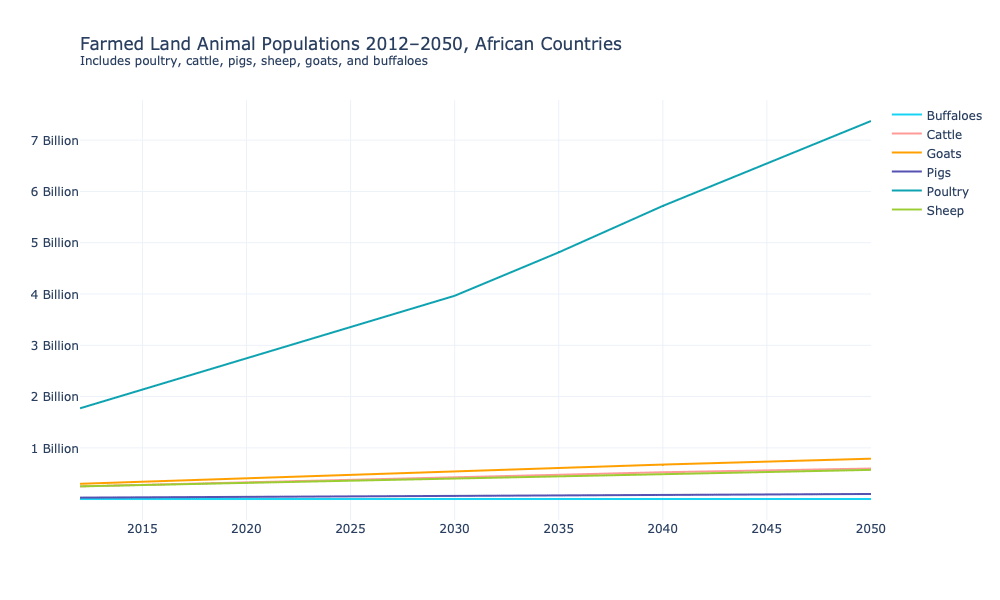As humanity continues its era of rapid population growth and rising economic prosperity, the demand for animal protein is anticipated to reach unparalleled heights. This surge in consumption is set to drastically impact the lives of farmed animals worldwide. Nowhere is this growth more pronounced than in Africa.
The evidence
Previously, our anticipation of Africa’s sharp increase in livestock numbers was primarily grounded in the historical global expansion of farmed animal populations over the past decades, coupled with human population growth trends across the African continent. This post, however, delves into the specific projections of farmed animal numbers and animal farming intensification from 2012 to 2050, as outlined by the Food and Agriculture Organization of the United Nations (FAO)*, which is based on many more factors than just historical changes in animal agriculture and human population growth, providing us with more detailed estimates than previously available. If not stated otherwise, all figures named in this blog post refer to these projections, which can be found here.
The FAO's projections encompass a range of future scenarios, including both a "business as usual" model and a "towards sustainability" model. For the scope of this post, we focus on the "business as usual" projection, which assumes the absence of any significant efforts to reduce the extent of factory farming. This allows us to explore the potential ramifications of the current trajectory of animal agriculture. Notably, even upon considering the projections from the “towards sustainability” model, the prospects for Africa remain largely unaltered. In contrast, for all other continents, we can observe a noticeable reduction in farmed animal numbers in comparison to the “business as usual” model. Although far from certain, this may indicate that the FAO assumes that growth in animal agriculture in Africa is close to unavoidable or that nothing will be done to hinder its growth.
The FAO provides data for farmed land animals, including cattle, pigs, sheep, goats, poultry, and buffaloes, but omits figures for other mammals, such as rabbits, horses, and dogs, as well as insects, fish, and seafood. This exclusion is noteworthy since the protein yield from smaller animals demands significantly greater numbers of individual animals per kilogram in contrast to large mammals like cows and pigs. Thus, while the analysis below offers crucial insights, it only represents a fraction of future developments.
Africa in global comparison
According to the FAO’s projections, the number of farmed land animals in Africa is anticipated to experience a remarkable surge in the coming decades. As shown in the graph below, the population of farmed land animals for the entire continent of Africa will rise from around 2.6 billion in 2012 to around 9.4 billion in 2050, an increase of 262%. Consequently, Africa would surpass all other global regions in terms of the total size of farmed animal populations by 2050, except for Asia, and reach roughly twice the total number of animals of other regions like Europe or North America.
At present, Asia leads and will continue to lead all continents in terms of the total number of farmed land animals. This can largely be attributed to factory farming in China, Indonesia, and India. Nevertheless, Africa’s livestock numbers are expected to increase by a much larger absolute number and at a higher rate than Asia’s projected 26% rise from 2012 to 2050.
Note that these numbers (along with all following numbers in this post) refer to the count of live animals at a given time in a year, which is not to be confused but should be highly correlated with the overall number of animals raised or slaughtered annually.
Nigeria and South Africa as key drivers of growth
Africa is a diverse continent and stating numbers for the whole of it overlooks many developments at the individual country level. While a sharp increase in farmed animal numbers is anticipated for most African countries, Nigeria and South Africa stand out, ranking second and third globally in terms of absolute livestock increase. Nigeria is expected to witness a four- to five-fold increase in farmed animals, from 358 million to 1.64 billion. South Africa will see a more than six-fold increase, from 250 million to 1.53 billion, as evident in the graph below.

Ethiopia and Ghana are two more notable countries, following Nigeria and South Africa in terms of absolute growth in livestock numbers. Ethiopia’s number of farmed animals is on track to rise from 135 million to 536 million (297%), and Ghana’s from 70 million to 414 million (491%).
Looking at the relative growth of farmed animal populations, different countries with smaller absolute increases stand out. Côte d’Ivoire is projected to experience the largest relative growth worldwide, with a 515% increase in the number of farmed animals, equating to 292 million more animals by 2050. Cameroon and Senegal also stand out**, with predicted growth rates of 438% (271 million more animals) and 406% (243 million more animals), respectively.
Farming intensification as a response to growth
Such intense growth in the number of farmed animals can only occur with the intensification of farming practices. While Africa currently has the least intensive animal agriculture sector worldwide, together with Asia and South and Central America, it is expected to witness the most significant intensification at 24-28%. Nigeria, South Africa, Ethiopia, and Ghana are anticipated to experience productivity increases of 37%, 8%, 53%, and 45% respectively. Guinea leads the global ranking in terms of productivity increase for multiple animal products, with rates of increase between 50% and 180% for beef cattle, dairy cows, and pigs. With its already high degree of industrialisation, South Africa is an outlier, as intensification is expected to increase further by only 8%. In total, out of the 25 countries with the highest productivity rise globally, 13 are found in Africa, including Côte d’Ivoire, Zimbabwe, and Liberia.
Species-specific trajectories
These developments will most severely affect chickens. Globally, the vast majority of farmed land animals are poultry, especially chickens, overshadowing other species. The number of farmed poultry worldwide is projected to increase by 53% from 22.2 billion in 2012 to 34.1 billion in 2050. In Africa alone, farmed poultry will more than triple from 1.8 billion to 7.4 billion. Additionally, Africa, and to a lower extent Asia, is likely to see substantial growth in farmed goats and sheep, a trend not mirrored in other continents. The two graphs below highlight the expected developments in the number of farmed animals per species, first between world regions and then within Africa only.
Conclusion
In summary, the projected surge in animal agriculture across Africa is nothing short of staggering, and demands a level of attention that far exceeds its current recognition. Remarkably, in 2020, the entire realm of animal advocacy throughout Africa is estimated to have received only one million USD of funding***, in stark contrast to the immense scope and impact of the expected changes. Within this context, the mission of Animal Advocacy Africa (AAA) becomes all the more apparent. AAA is currently conducting a research project in collaboration with Bryant Research aimed at identifying appropriate, feasible, and evidence-based strategies to mitigate the trend outlined in this blog post. In addition, AAA is running a training program to develop a pool of advocates ready to be mobilized for establishing new farmed animal advocacy initiatives in line with the research project’s findings or to work at existing organizations in Africa. As the landscape of animal agriculture in Africa changes, empowering animal advocacy organizations and individuals in Africa is a crucial step to ensure that progress towards a more compassionate and sustainable food system is achieved. If you think our work is important and want to contribute to it, consider working with us or donating – we value every contribution!
* The FAO projections are based on identifying, quantifying and modeling key drivers of future changes, including GDP, population, as well as agricultural technology and production. More information can be found here.
** Looking at a combination of absolute numbers and relative growth rate could be a relevant factor when considering where to start and support animal advocacy organizations. Prioritizing countries with high absolute numbers and high relative growth and deprioritizing countries with low absolute numbers and low relative growth seems sensible. However, it is not quite clear how to weigh countries with high absolute numbers but low relative growth versus low absolute numbers but high relative growth against each other. Although looking at absolute growth numbers can help prioritizing African countries in terms of the scale of the problem, additionally looking at relative growth may be relevant for estimating the tractability of animal advocacy organizations’ work, since efforts like implementing new policies may be easier in countries where animal agriculture is still on a smaller scale.
*** This estimate comes from an upcoming research report by Animal Advocacy Africa. For older figures, one can also refer to Lewis Bollard’s estimates here.





What a fantastic post thanks!
Personally I think farmed animal numbers will rise faster than you projected in other African countries too - it all depends on how quickly they develop. I'm guessing Uganda is one of your lower lines, but I wouldn't be surprised if it is already increasing faster than that
Here in Gulu Northern Uganda, even in the last 10 years we've gone from the situation where most people ate almost exclusively animals which were reared on personal homesteads or farms (either home kill or bought locally to market) to the advent of factory farming, especially among chickens. When I first came here there were maybe 5 stalls selling fried chicken in town, now there are over 50.
Of all animals in Uganda, I'm fairly certain layers have the highest degree of suffering. Many "broilers" are brought up in barns, which are still bad but not as bad as battery cages.
My very uncertain personal opinion is that most home reared animals have net positive lives, and were good for the nutrition of the family so that was actually a pretty good situation. Now we are quickly descending from perhaps a slight net good to a massive net harm which is aweful to see in front of my eyes.
Thank you for your comment. Very insightful to hear about your direct experience in Uganda and how animal production is changing "right before your eyes"!
This is exactly the kind of development we are concerned about and are trying to address. Just like you, we are very uncertain about the quality of animal lives under subsistence farming. But we do think that a shift towards factory farming would be a massive net harm for animals.
Of course, farmed animal numbers might rise even faster than shown in our analysis, as you suspect. We are relying on projections from the FAO, since this is the only dataset we are aware of where animal numbers have been modelled globally until 2050. Needless to say, there are a lot of uncertainties and assumptions involved in such modelling. Precise numbers should thus be taken with caution, but the overall trend suggested by the data (i.e. Africa vs. other world regions) should be robust.
Uganda is just outside of the top 25 countries globally when it comes to the absolute increase in farmed land animal numbers in our analysis. Please see the graph below for a deep-dive into all African countries.
We would also like to highlight the work of one of our partner organisations in Uganda: Animal Welfare Competence Center For Africa. Based on our strategic support and a research report produced in partnership with Animal Ask, they started a project on government outreach to stop or slow the growth of industrial animal agriculture in Uganda, funded by the EA Animal Welfare Fund.
Thank you very much for the post! Very useful information.
For people who are working on or interested in animal welfare in Africa, this post might useful too:
The Epidemic of Second-Hand Battery Cages Being Imported into Africa: What does this mean for the cage-free movement in Africa? — EA Forum (effectivealtruism.org)
Very interesting post, I haven't thought about animal welfare in Africa before. I guess the first thing I (and most others) think of when I imagine philanthropy in Africa is human poverty and disease. With this perspective in mind, I wonder how this impacts funding sources from the western world... Getting money out of the "animal welfare budget" for this will probably work! But getting money out of the "philanthropy in Africa" budget I imagine will be very challenging.
Executive summary: Farmed animal populations in Africa are projected to rapidly increase from 2012 to 2050, especially in Nigeria, South Africa, Ethiopia, and Ghana. This will require intensification of animal agriculture and drastically impact animal welfare.
Key points:
This comment was auto-generated by the EA Forum Team. Feel free to point out issues with this summary by replying to the comment, and contact us if you have feedback.
Some questions I would be interested in:
Thank you for your comment. Those are very relevant questions! They are also quite complex and hard to give a clear answer to. Some thoughts below.
The FAO blithely projects a doubling of the population of farmed animals but such a doubling would presumably require a doubling of feedstuffs for those animals. The world is already using half of the available habitable land (71% of all land) and large quantities of ocean animals to feed the existing farmed animal population. If twice as many farmed animals have to be fed, then presumably that would require using all of the habitable land for agriculture (to produce feed for the greater number of animals. That leaves no land for wild animals or forests (or other human needs). This is undoubtedly a simplistic calculation but doubling the number of farmed animals would certainly have disastrous consequences for biodiversity and current land-based carbon sinks.
I would like to see a projection that looks at future animal populations plus the options for feeding those animals from existing land and marine sources.
In addition, just because someone projects that the world will reach a particular condition does not mean that such a condition is inevitable. At one point, population scientists projected that the world population would peak at around 12.4 billion people.
However, their projections have fallen. Forecasts now suggest that there will be 8.9 billion people by 2100 (1 billion more than today). That number could be driven even lower if the world was better at preventing a larger portion of unintended pregnancies.
Andrew Rowan, D.Phil.
President, WellBeing International
Crop yields are extremely low in much of Africa so my guess is there's potential for farmed animals to be fed while keeping constant or even decreasing land use.
Thank you for your comment. We appreciate critical questions and thoughts!
Of course, changes in farmed animal numbers might be quite different than projected. We are relying on projections from the FAO, since this is the only dataset we are aware of where animal numbers have been modelled globally until 2050. Needless to say, there are a lot of uncertainties and assumptions involved in such modelling. Precise numbers should thus be taken with caution. However, we think that the overall trend suggested by the data (i.e. Africa vs. other world regions) should be robust, as the African continent has the fastest-growing populations in the world and most countries are still early in their economic development (which is highly correlated with animal product consumption).
Thomas' comment also seems highly relevant, as there is still a lot of potential for crop yields to grow massively in many African countries. Hannah Ritchie also talked about this in depth on an 80K Hours podcast episode.